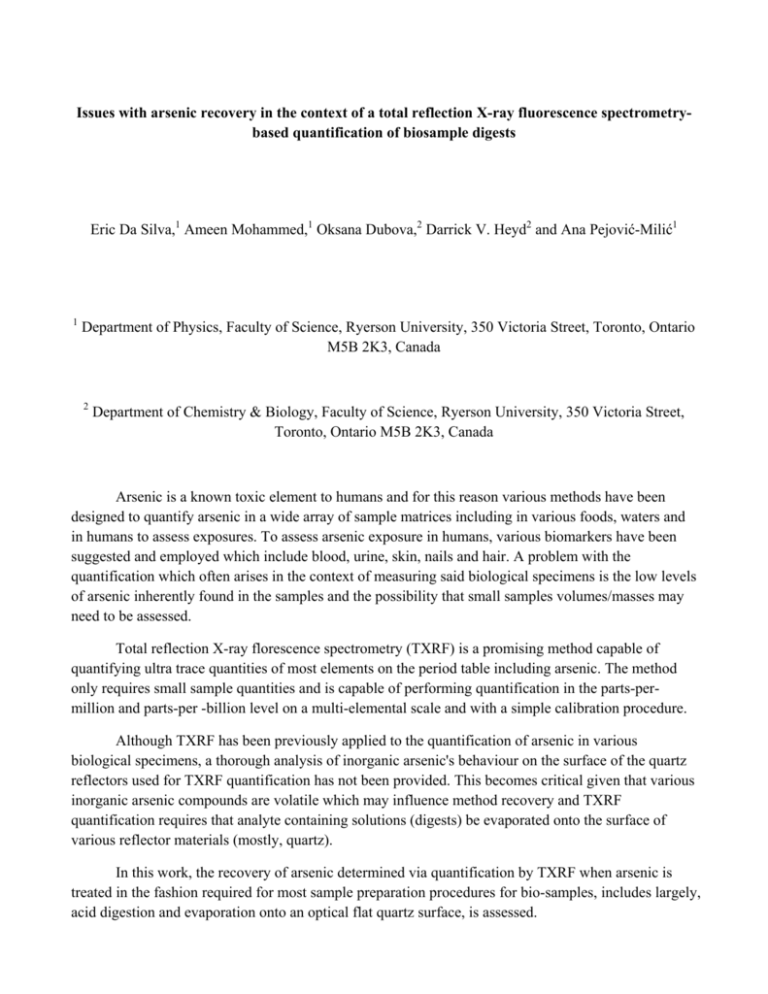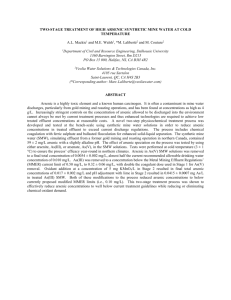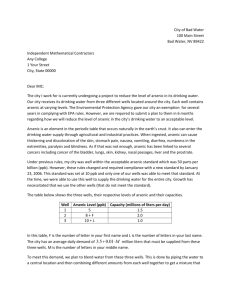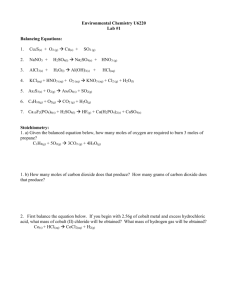Issues with arsenic recovery in the context of a total reflection X
advertisement

Issues with arsenic recovery in the context of a total reflection X-ray fluorescence spectrometrybased quantification of biosample digests Eric Da Silva,1 Ameen Mohammed,1 Oksana Dubova,2 Darrick V. Heyd2 and Ana Pejović-Milić1 1 Department of Physics, Faculty of Science, Ryerson University, 350 Victoria Street, Toronto, Ontario M5B 2K3, Canada 2 Department of Chemistry & Biology, Faculty of Science, Ryerson University, 350 Victoria Street, Toronto, Ontario M5B 2K3, Canada Arsenic is a known toxic element to humans and for this reason various methods have been designed to quantify arsenic in a wide array of sample matrices including in various foods, waters and in humans to assess exposures. To assess arsenic exposure in humans, various biomarkers have been suggested and employed which include blood, urine, skin, nails and hair. A problem with the quantification which often arises in the context of measuring said biological specimens is the low levels of arsenic inherently found in the samples and the possibility that small samples volumes/masses may need to be assessed. Total reflection X-ray florescence spectrometry (TXRF) is a promising method capable of quantifying ultra trace quantities of most elements on the period table including arsenic. The method only requires small sample quantities and is capable of performing quantification in the parts-permillion and parts-per -billion level on a multi-elemental scale and with a simple calibration procedure. Although TXRF has been previously applied to the quantification of arsenic in various biological specimens, a thorough analysis of inorganic arsenic's behaviour on the surface of the quartz reflectors used for TXRF quantification has not been provided. This becomes critical given that various inorganic arsenic compounds are volatile which may influence method recovery and TXRF quantification requires that analyte containing solutions (digests) be evaporated onto the surface of various reflector materials (mostly, quartz). In this work, the recovery of arsenic determined via quantification by TXRF when arsenic is treated in the fashion required for most sample preparation procedures for bio-samples, includes largely, acid digestion and evaporation onto an optical flat quartz surface, is assessed. Our results indicate that evaporation of arsenic containing digests onto an optically flat quartz surface results in up to a 50% loss in arsenic [as As(III)]. Raman micro-spectrometry measurements indicate that the evaporation of solutions containing inorganic arsenic on quartz surfaces results in the formation arsenious acid nanoparticles which are prone to sublimation. The results indicate that future work is required in resolving this issue, which may require arsenic specific sample pre-treatment procedures, as the direct analysis of arsenic by TXRF, as has previously been proposed, using conventional approaches is prone to issues with analyte recovery.








